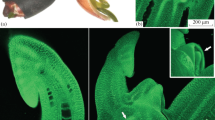Abstract
Whole seeds, excised embryos, and excised endosperm ofSantalum album were aseptically cultured with a view to studying seed germination in isolation from the host species, and to establishing callus cultures from both embryo and endosperm for comparative studies et their morphogenesis. Seed germination and seedling formation occurred normally only on modified White's medium supplemented with casein hydrolysate or coconut milk, or with both substances. Neither the excised embryo nor the endosperm grew on any of the culture media tested. However in about 17 per cent seed cultures on White's medium supplemented with 2,4-D, kinetin, and yeast extract, the endosperm degenerated, whereas the embryo callused and subsequently differentiated into innumerable embryoids; eventually the embryoids developed into normal plantlets. Callusing of the endosperm occurred also in seed cultures on four media supplemented variously with 2,4-D, kinetin, and yeast extract. Although the endosperm tissue grew through several passages no organ fornation was observed.
Abstract
Celistvá semena, extirpovaná embrya a extirpovaný endosperm rostlinSantalum album byly kultivovány za aseptických podmínek. Účelem práce bylo studovat klíčení semen v nepřítomnosti hostitelské rostliny a získat kalusové kultury z embryí i endospermu k srovnávacím morfogenetickým pokusům. Klíčení semen a utváření klíčních rostlin probíhalo normálně pouze na Whiteově mediu, k němuž byl dodán kasein-hydrolysát nebo kokosové mléko, anebo obě tyto látky. Extirpovaná embrya ani endosperm nerostly na žádném z testovaných kultivačních medií. V 17 % semen kultivovaných na Whiteově mediu, doplněném 2,4-D, kinetinem a kvasničným extraktem, docházelo k degeneraci endospermu, kdežto z embrya se vytvořil kalus, který postupně diferencoval ve velmi četné embryoidy; z embryoidů se nakonec vyvinuly normální rostlinky. K tvorbě kalusů z endospermu došlo také v semenech kultivovaných na čtyřoch půdách, k nimž byly přidány 2,4-D, kinetin a kvasničný extrakt v různých kombinacích. Ačkoliv pletivo z endospermu rostlo po několik pasáží, nebyla pozorována tvorba orgánů.
Similar content being viewed by others
References
Bhojwani, S. S.: Differentiation of haustoria in the germinating embryos of mistletoe without host stimulus.—Experientia25: 543–544, 1969.
Fineran, B. A.: Studies on the root parasitism ofExocarpus bidwillii Hook. f. VI. Haustorial attachment to non-living objects and the phenomenon of self-parasitism.—Phytomorphology15: 387–399, 1965.
Johnson, F.: Transmission of plant viruses by dodder.—Phytopathology31: 649–656, 1941.
Johri, B. M.: Chemical induction of polyembryony.—In:Ramakrishnan, C. V. (ed.): Tissue Culture.—Dr. W. Junk N. V. Publishers. The Hague, pp. 330–337, 1965.
Johri, B. M., Bajaj, Y. P. S.: In vitro response of the embryo ofDendrophthoe falcata (L. f.)Ettings.—In:Maheshwari, P., Rangaswamy, N. S. (ed.): Plant Tissue and Organ Culture —A Symposium, Intern. Soc. Pl. Morphologists, Delhi, pp. 292–301, 1963.
Johri, B. M., Babaj, Y. P. S.: Growth responses of globular proembryos ofDendrophthoe falcata (L. f.)Ettings in culture—Phytomorphology15: 292–300, 1965.
Johri, B. M., Nag, K. K.: Experimental induction of triploid shoots in vitro from endosperm ofDendrophthoe falcata (L. f.)Ettings.—Curr. Sci.37: 606–607, 1968.
Kristensen, H. R.: The sandal spike disease.—FAO, ETAP Report to Government of India, No. 1229: 1–31, 1960.
Maheshwari, P., Baldev, B.: In vitro induction of adventive buds from embryos ofCuscuta reflexa Roxb.—In: Plant Embryology—A Symposium, C.S.I.R., New Delhi, pp. 129–138, 1962.
Maheshwari, P., Rangaswamy, N. S.: Embryology in relation to physiology and genetics.— In:Preston, R. D. (ed.): Adv. bot. Res.2: 219–321, 1965.
Petrů, E.: Development of embryoids in carrot root calllus culture (Daucus carota L.).—Biol. Plant.12: 1–5, 1970.
Raghavan, V., Torrey, J. G.: Inorganic nitrogen nutrition of the seedlings of the orchidCattleya.—Amer. J. Bot.51: 264–274, 1964.
Rangan, T. S., Rangaswamy, N. S.: Morphogenic investigations on parasitic angiosperms. I.Cistanche tubulosa (Orobanchaceae).—Can. J. Bot.46: 263–266, 1968.
Rangan, T. S., Rangaswamy, N. S.: Morphogenic investigations in parasitic engiosperms. III.Cassytha filiformis (Lauraceae).—Phytomorphology19: 292–300, 1969.
Rangaswamy, N. S.: Experimental studies on female reproductive structures ofCitrus microcarpa Bunge.—Phytomorphology11: 109–127, 1961.
Rangaswamy, N. S.: Studies on culturing seeds ofOrobanche aegyptiaca Pers.—In:Maheshwari, P., Rangaswamy, N. S. (ed.): Plant Tissue and Organ Culture—A Symposium Intern. Soc. Pl. Morphologists, Delhi, pp. 345–354, 1963.
Rangaswamy, N. S.: Morphogenesis of seed germination in angiosperms.—Phytomorphology (Maheshwari Memorial Vol.)17: 477–487, 1967.
Rangaswamy, N. S., Rao, P. S.: Experimental studies inSantalum album.—establishment of tissue culture of endosperm.—Phytomorphology13: 450–454, 1963.
Rao, L. N.: Parasitism in theSantalaceae.—Ann. Bot. (N.S.)6: 131–150, 1942.
Rao, M. R.: Germination and growth of sandal seedlings.—Ind. For. Rec.2: 137–157, 1910.15: 175–179, 1965.
Srimathi, R. A., Sreenivasaya, M. S.: Studies on the culture of root tips, haustoria and lateral buds ofSantalum album L.—In:Maheshwari, P., Rangaswamy, N. S. (ed.): Plant Tissue and Organ Culture—A Symposium, Intern. Soc. Pl. Morphologists, Delhi, pp. 55–57, 1963.
Sussex, I. M., Frei, K. A.: Embryoid development in long-term tissue cultures of carrot.— Phytomorphology18: 339–349, 1968.
Truscott, F. H.: Some aspects of morphogenesis inCuscuta gronovii.—Amer. J. Bot.53: 739–750, 1966.
Varma, A., Chenulu, V. V., Raychaudhuri, S. P., Prakash, N., Rao, P.: Mycoplasma-like bodies in tissues infected with sandal spike and brinjal little leaf.—Ind. Phytopath.22: 289–291, 1969.
Ziebur, N. K., Brink, R. A.: The stimulative effect ofHordeum endosperms on the growth of immature plant embryosin vitro.—Amer. J. Bot.38: 253–256, 1951.
Author information
Authors and Affiliations
Rights and permissions
About this article
Cite this article
Rao, P.S., Rangaswamy, N.S. Morphogenic studies in tissue cultures of the parasiteSantalum album L.. Biol Plant 13, 200–206 (1971). https://doi.org/10.1007/BF02933637
Received:
Published:
Issue Date:
DOI: https://doi.org/10.1007/BF02933637




